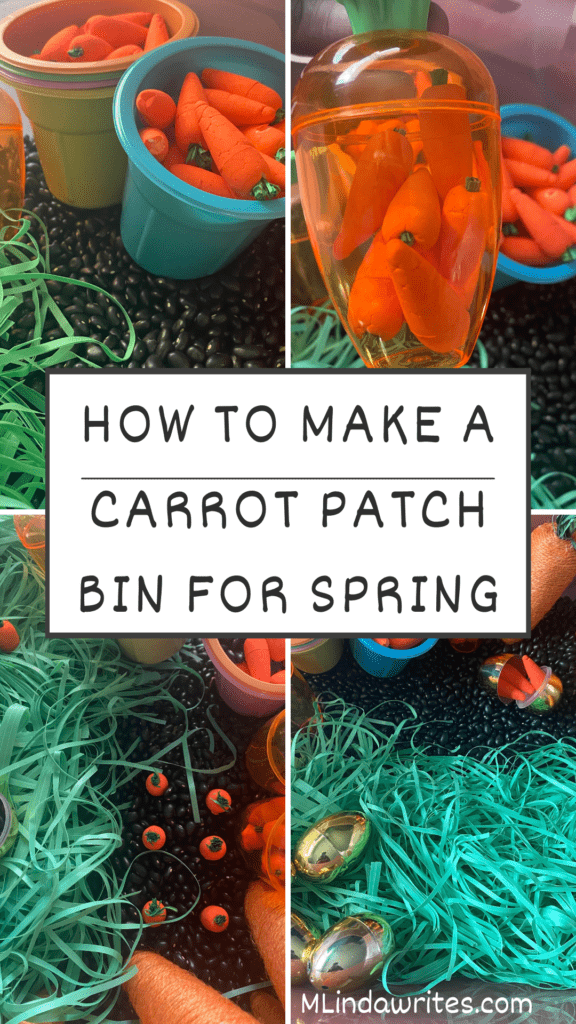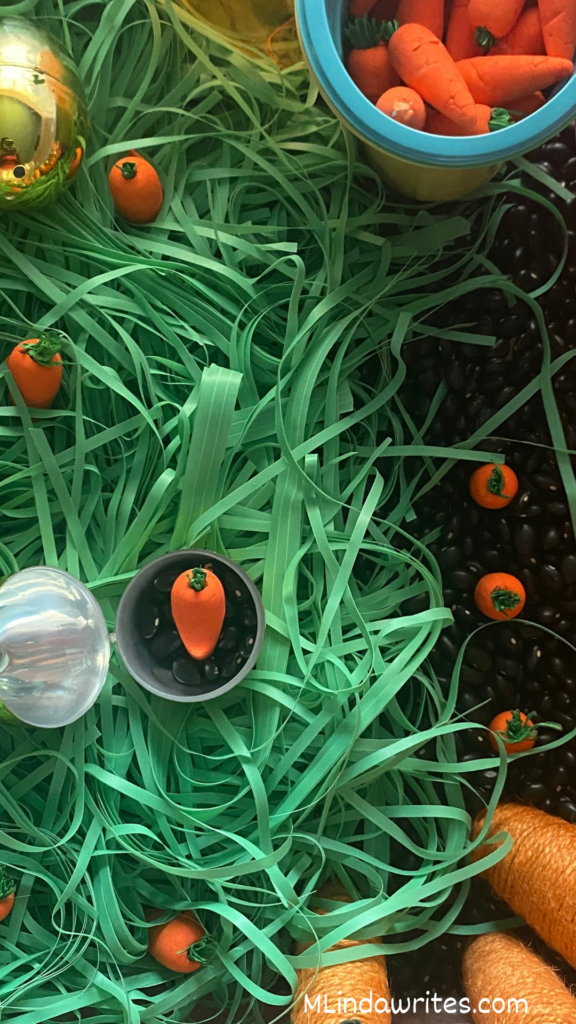
Hello and happy Spring MLinda family! Are you looking for a fun and creative way to introduce the Spring season to your child? Why not try creating a Spring sensory bin filled with Spring-related items? We’re wild for carrots and how bright and beautiful they are. Creating an easy spring garden sensory bin is effortless.
You’ll be amazed at how your little ones light up when you show them the beauty of Nature and gardening. My son Anthony is fond of carrots, so we made an easy spring sensory garden themed on carrots and gardening.
We enjoy the pleasant weather in Florida, and gardening is a calming activity. Although we have a lovely outdoor garden, we don’t have any carrots. However, we’re hoping to grow some tomatoes and cilantro soon.
In addition, there are many exciting options for indoor gardening. I made this sensory bin to teach Anthony a fun way to learn and play indoors when he was younger.
This easy spring sensory bin is not just limited to Spring. You can use it in numerous ways throughout the year. It’s a versatile and fun activity that your little one will appreciate. I have found using fun games to help the bin become a spring sensory bin full of wonder.
This page contains affiliate links, and I earn a commission if you make a purchase through one of the links at no cost to you. As an Amazon Associate, I earn from qualifying purchases.
Pinterest is where creative ideas are born!
I was scoping through Pinterest, and I saw this awesome pin:
And boom! An idea was born, and a carrot patch came into mind with a similar image.
I love the gardening tools they used, and it looks like a real garden. Inspired by it, I created Anthony’s garden with a few twists.
I added some fake grass to give it a spring flare. Out of all the spring sensory bins, this one is my favorite.
You can tap the icons above and below this page to contact me through Facebook, Twitter, LinkedIn, or Pinterest. If you need writing services, you can also use this form here.
Let’s get creative!
You can get creative and add spring-related items to the bin to introduce your child to a new season. Watch their faces light up as you show them new things and the beauty of Nature and gardening.
Let’s create an adorable carrot patch bin perfect for exploring the many textures. This project is super fun and easy to create, making it an excellent activity for kids of all ages.
In less than 10 minutes, you can have a full carrot garden for your gardener to dig in without worrying about the dirt mess all over your home. A few beans here and there are fine
This project is super fun and easy to customize, making it an excellent activity for kids of all ages.
You will need a few materials, which I will happily share below.
Creating an adorable carrot patch spring sensory bin perfect for exploring different textures is fun and easy, making it a great activity for kids of all ages.
In under 10 minutes, you can have a full carrot garden for your little gardener to dig in without worrying about dirt all over your home.
A few beans here and there won’t hurt either. Anthony gets a few beans on the floor but cleans them up without a problem.
To make this project even more exciting, you can customize it by adding items perfect for hiding eggs or collecting treats. With the tips below, you can create a Spring garden sensory bin that your child will love.
Materials

- Medium or Large container (any size will work!)
- 7-10 bags of black beans (you can find them very cheap at your local grocery stores if you buy them without a brand name)

- Fake grass (1 pack)
- Mini carrots (2-3 packs)
- Large carrots (1-2 packs; cut the sticks off to make them safe for the spring sensory bin or find an alternative plush carrot for little hands)
- Golden eggs (optional for hiding treats)
Now that we have the materials to make this awesome carrot patch, let’s start!
Setting Up Your Spring Sensory Bin Garden

The Base for your Spring sensory bin
Choose a large bin or container. A plastic under-bed storage bin or a kiddie pool works well. Fill your pretend garden with a sensory base that provides a fun texture. Below are more fun options for unique bases to try or incorporate into your sensory bin.
- Uncooked black Beans: Dried beans like pinto or black beans offer a smooth feel with a gentle sound.
- Crinkled Paper: Shredded green construction paper creates a colorful, slightly noisy base.
- Oatmeal: Ground oatmeal provides a soft and calming texture.
The Veggies
No carrot patch is complete without carrots! Include a variety of textures and colors to make your garden come to life this Spring.
- Plastic Carrots: These classic toys come in different sizes and are perfect for burying and harvesting.
- Felt Carrots: Soft and huggable, felt carrots add a cuddly element.
- Pom Poms: Orange pom poms represent baby carrots for planting or hiding within the sensory base.
The Tools
Gardening tools add to the pretend play aspect. Consider:
- Small gardening tools: Toy trowels, rakes, and watering cans enhance the realistic feel.
- Cups and Spoons: Simple household items work well for scooping and pouring the sensory base.
- Craft Sticks: These can be used for digging, stirring, and creating pretend fences.
The Extras
Spice up your sensory garden with additional elements:
- Fake Flowers: Add a touch of spring with colorful plastic or felt flowers.
- Green Pipe Cleaners: These can represent carrot tops or be used for pretend weeding.
- Small Animals: Include plastic bugs or farm animals for imaginative play. You can get these relatively cheap at the dollar store.
Let the Spring sensory bin Fun Begin!
With your sensory garden set up, it’s time for the little gardeners to explore! Here are some ideas to get them started:
- Planting and Harvesting: Children can use the toy tools to “dig” holes in the sensory base and “plant” the pom poms or small felt carrots. Encourage them to “water” their carrots with toy watering cans and “harvest” them later.
- Sorting and Matching: If you’ve included different-colored carrots, have children sort them by size or color. This will be an exciting activity for your kids to do.
- Counting Carrots: Use the carrots for simple counting activities. Ask children to count how many carrots they plant or harvest.
- Sensory Exploration: Encourage children to describe how the different elements feel: the smoothness of the beans, the crinkle of the paper, and the softness of the felt carrots.
- Imaginative Play: Let the children take the lead! They may build fences with craft sticks, create stories about the toy animals, or have a carrot-themed tea party with their felt carrots.
Learning Through Spring Sensory Bin Play
Your adorable carrot patch Easter bin is complete! Now you have the perfect container for sensory fun this Spring. This project is a fun way to get creative and celebrate the spring season. Happy Easter!
The vibrant orange of carrots and the act of getting your hands dirty in the “soil” make a carrot sensory garden a delightful activity for children of all ages. This activity engages multiple senses and encourages exploration and learning through play.
This sensory activity offers a multitude of benefits for young children:
- Sensory Development: Children engage their senses of touch, sight, and sound through the various textures, colors, and sounds of the materials.
- Fine Motor Skills: Scooping, pouring, digging, and manipulating small objects help strengthen hand-eye coordination and fine motor skills.
- Imaginative Play: The pretend play aspect encourages creativity and storytelling skills.
- Early Math Concepts: Sorting, counting, and comparing sizes introduce basic math concepts in a fun way.
- Science Exploration: Children can learn about planting and harvesting as they pretend to grow carrots.
Beyond the Bin
Extend the learning by reading a children’s book about carrots, such as “The Carrot Seed” by Ruth Krauss. You can even visit a local farmers market or garden to see real carrots growing!
It is so fun to see plants growing! Having our own
Cleaning Up and Storing Spring garden sensory bin
Have your little gardeners help clean up the bin after playtime. Store the sensory base in an airtight container for future use. Wash any plastic toys and put everything away for the next time your child wants to dig into some carrot-filled fun!
With a little creativity, a carrot sensory garden can provide hours of engaging and educational play for your children.
Enjoy your time with your child. The things we can do with homemade items are wonderful. It’s a world of imagination when you create sensory bins. The hours of fun are countless, not to mention the bonding and connection made.
You can tap the icons above and below this page to contact me through Facebook, Twitter, LinkedIn, or Pinterest. If you need writing services, you can also use this form here.

